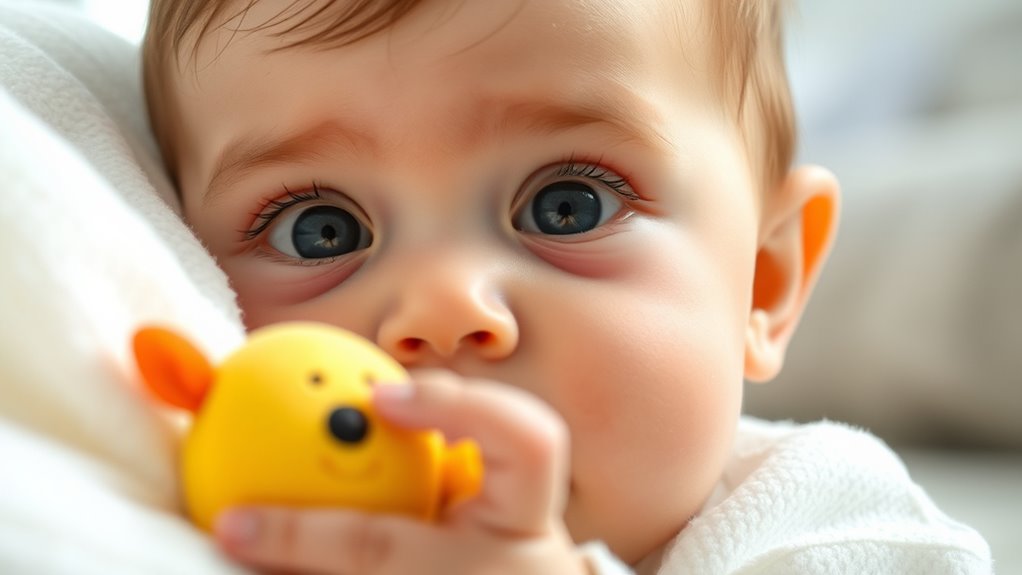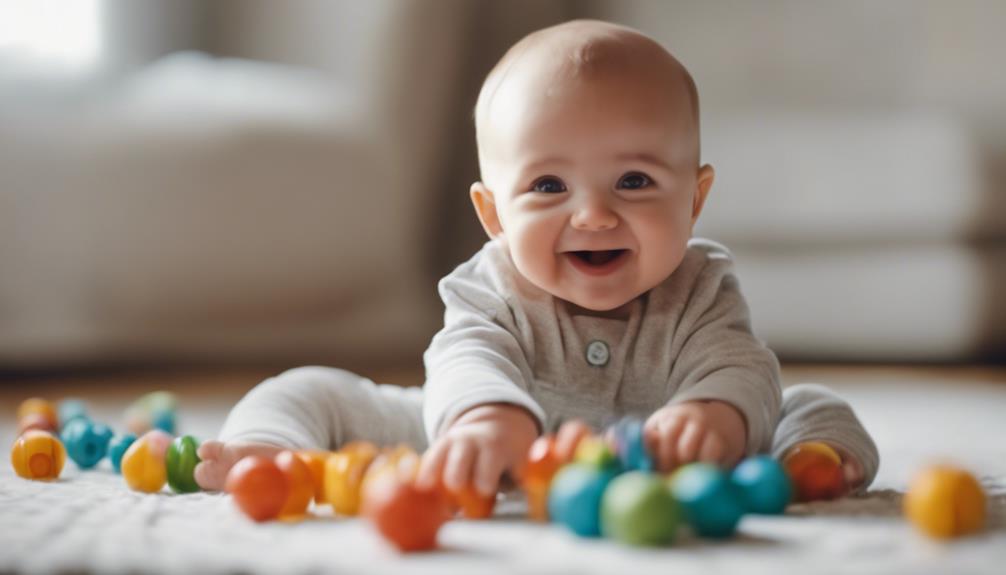Babies love peekaboo because it helps them understand object permanence—the idea that objects and people still exist even when out of sight. This game supports their brain development by strengthening their visual tracking, memory, and problem-solving skills. When you play peekaboo, you’re encouraging your little one’s cognitive growth and emotional security. Keep exploring this fascinating stage, and you’ll discover how such simple games fuel their long-term learning and confidence.
Key Takeaways
- Peekaboo reinforces object permanence by showing babies that objects and people continue to exist even when out of sight.
- Playing peekaboo helps develop sensorimotor skills like visual tracking and searching for hidden objects.
- It promotes cognitive growth by teaching babies about continuity and consistency in their environment.
- Peekaboo encourages social bonding, turn-taking, and emotional security, supporting overall emotional development.
- Repeated interactions during peekaboo strengthen memory, problem-solving, and foundational brain development skills.
Understanding Object Permanence and Its Significance

Understanding object permanence is essential because it reveals how infants begin to grasp that objects continue to exist even when they can’t see or hear them. During this stage, your baby develops key sensorimotor skills, which involve coordinating their senses with movement. One important milestone is improving visual tracking, allowing your little one to follow objects as they move. As they watch objects disappear and reappear, they start to understand that hidden items still exist, even if they’re not in plain sight. This cognitive leap marks the beginning of their awareness that the world is consistent and reliable. Developing object permanence helps lay the foundation for later complex thoughts and problem-solving, making it a crucial step in your baby’s overall brain growth. Additionally, this stage signals the development of sensorimotor skills, which are vital for their overall cognitive and physical development. Recognizing that objects are permanent even when out of sight fosters trust and security as your baby explores their environment. Cultivating a sense of trust during this phase can support their emotional development and confidence in exploring new experiences. Furthermore, understanding how infants develop brain connections related to object permanence underscores the importance of responsive caregiving during this critical period.
How Peekaboo Supports Cognitive Growth

Playing peekaboo helps your child understand that objects and people still exist even when they’re out of sight. It also encourages social interaction, building their confidence and communication skills. Together, these activities strengthen their grasp of object permanence and support their overall cognitive growth.
Reinforces Object Permanence
Peekaboo actively reinforces object permanence by encouraging your child to realize that objects and people continue to exist even when they’re out of sight. This game helps develop their sensorimotor skills as they learn to anticipate and search for hidden objects, strengthening their understanding of continuity. As you play, your baby begins to connect the idea that what’s unseen still exists, boosting their cognitive growth. Additionally, peekaboo fosters emotional bonding, as your repeated interactions build trust and comfort. When you hide and reveal yourself, your baby learns to associate your presence with positive feelings, reinforcing their sense of security. Recognizing the importance of consistent routines can also enhance their learning experience, as regular interactions support stable cognitive development. Over time, these experiences lay a strong foundation for more complex cognitive skills, including memory and problem-solving, all while deepening your emotional connection.
Encourages Social Interaction
Engaging in peekaboo encourages your child to interact socially, fostering essential communication skills. As you play, your baby learns to read facial expressions, respond to your voice, and initiate interactions, which build their confidence. This activity strengthens social bonding, creating a sense of emotional security that helps your little one feel safe and loved. When you hide and reveal yourself, your baby begins to understand turn-taking and the concept of shared attention, key components of social development. These interactions also lay the groundwork for empathy and understanding others’ emotions. Additionally, incorporating safe sleep practices into your routines can further support your baby’s overall development and well-being. Recognizing the importance of emotional support during this stage helps nurture your child’s resilience and positive emotional growth. By consistently engaging in peekaboo, you help your child develop crucial social skills that support their overall cognitive growth and emotional well-being. Moreover, understanding brain development stages can help you tailor activities like peekaboo to optimize your child’s learning experiences.
The Stages of Object Permanence Development in Babies

As your baby grows, they move through different stages of understanding that objects continue to exist even when out of sight. In the early stage, they recognize familiar objects, but their grasp is still developing. Eventually, they develop an advanced understanding, realizing that objects have a lasting presence beyond what they see. During this development, the concept of object permanence becomes clearer as they begin to understand the enduring nature of things outside their immediate perception.
Early Stage Recognition
During the earliest stages of development, babies begin to show signs of recognizing that objects continue to exist even when they’re out of sight. During this early stage, your baby engages in sensorimotor exploration, using their senses to investigate their environment. They develop basic abilities like visual tracking, following moving objects with their eyes, which is vital for understanding object permanence. At this point, they might notice when a toy disappears behind a blanket but may not yet understand it still exists. This stage is marked by simple reactions—like searching briefly for a hidden object or looking longer at familiar items. These behaviors indicate that your baby is gradually building the foundation for recognizing that objects persist beyond immediate view. Additionally, research shows that with continued development, infants begin to understand object constancy, realizing that objects remain the same even when their appearance changes or they are temporarily hidden. This understanding is a crucial step in cognitive development, as it reflects an increasing awareness of a stable and predictable environment. Recognizing this concept is an important milestone in biodiversity basics, as it reflects an understanding of consistent existence amidst change. Furthermore, understanding how energy efficiency applies to their environment can help infants develop awareness of sustainable practices as they grow.
Advanced Object Understanding
As babies’ cognitive skills mature, their understanding of object permanence becomes more sophisticated. They begin to recognize that objects continue to exist even when out of sight, thanks to improved sensorimotor skills and visual tracking. At this stage, your baby can:
- Follow hidden objects with their eyes, demonstrating better visual tracking.
- Search for partially hidden objects, showing growing awareness of object permanence.
- Understand that objects still exist even if they’re briefly out of view, reflecting advanced sensorimotor development.
- Develop a mental representation of objects, enabling them to anticipate where an object might be hidden based on prior experience. This development is supported by the maturation of neural pathways involved in brain development and cognitive processing.
These milestones indicate your baby is progressing from simple recognition to a deeper understanding of object consistency. Their ability to anticipate where objects are hidden reveals they’re developing a mental representation that supports more complex cognitive processes.
Signs Your Baby Is Grasping Object Permanence

When your baby begins to understand that objects continue to exist even when out of sight, you’ll notice certain behaviors that signal they are grasping object permanence. These sensorimotor milestones often appear around 8 to 12 months and mark important developmental milestones. For example, your baby might look for a hidden toy or try to retrieve it after it’s been covered. They may also search behind objects or lift a cloth to find a toy underneath. These actions show they’re beginning to understand that things don’t just disappear, but still exist even when hidden. Recognizing these signs helps you see your baby’s progress in understanding the world around them and their growing cognitive abilities. Observing their curiosity about hidden objects further indicates their developing understanding of object permanence.
Activities to Enhance Your Baby’s Understanding of Hidden Objects

Engaging your baby in simple activities can effectively boost their understanding of hidden objects. These activities encourage sensory exploration and develop fine motor skills while reinforcing object permanence. To make learning fun and effective, try these activities:
- Cover and uncover toys with a cloth, encouraging your baby to lift it and find the hidden object, enhancing their sensory exploration and fine motor control.
- Use cups or containers to hide small toys, then encourage your baby to find and retrieve them, fostering curiosity and understanding of hidden objects.
- Play peekaboo with soft scarves or hands, helping your baby associate visibility and invisibility, which strengthens their grasp of object permanence through active participation.
These activities support brain development and help your baby understand that objects continue to exist even when out of sight.
The Long-Term Benefits of Developing Object Permanence

Developing object permanence in your baby yields significant long-term benefits that extend well beyond early childhood. When your child understands that objects continue to exist even when out of sight, they build emotional resilience, feeling more secure and confident as they explore their world. It also enhances problem-solving skills, enabling them to think critically and persist when faced with challenges. Consider how this understanding fosters independence and patience over time. Regularly practicing mindful decluttering strategies can support this developmental milestone by creating an environment that encourages curiosity and exploration. Additionally, fostering a sense of object permanence helps children develop a foundation for future learning and cognitive growth. Recognizing the importance of early developmental milestones can guide parents to support their child’s overall growth effectively. Developing this skill also plays a role in building secure attachments, which are crucial for healthy emotional development. Moreover, understanding how brain development unfolds during early childhood highlights the importance of nurturing these cognitive skills early on.
Frequently Asked Questions
When Do Most Babies Typically Develop Object Permanence?
Most babies typically develop object permanence around 8 to 12 months old, though tracking milestones can vary. During this period, your little one begins understanding that objects still exist even when out of sight, which is a key developmental timeline. You’ll notice this when they enjoy games like peekaboo more, as they start to grasp that hidden items or people aren’t gone forever, marking an exciting growth milestone.
Can Delayed Object Permanence Indicate Developmental Issues?
You’re right to wonder if delayed object permanence signals trouble. While developmental milestones vary, missing key signs might be an early warning of developmental issues. If your baby doesn’t show understanding of object permanence by the typical age, it’s worth consulting a specialist. Remember, every child develops at their own pace, but staying alert helps ensure timely support if needed. Keep a close eye—sometimes, a delayed response is just a sign to dig deeper.
How Does Object Permanence Relate to Later Problem-Solving Skills?
You might wonder how object permanence affects your child’s problem-solving skills later on. As a key cognitive milestone, developing object permanence helps your child understand that objects exist even when out of sight, which boosts their reasoning abilities. If there’s a delay in this milestone, it could signal developmental delays that might impact future problem-solving. Supporting their curiosity and play can foster these skills, promoting healthy cognitive development.
Are There Specific Toys That Better Support Object Permanence?
Think of toys as your baby’s secret agents for learning. Interactive toys and sensory play items, like peekaboo curtains or textured blocks, are perfect for supporting object permanence. They keep your baby engaged and help them understand that objects still exist even when out of sight. Choose toys that encourage exploration and surprise, making the learning process fun and natural as your little one develops important cognitive skills.
How Can Parents Encourage Object Permanence in Non-Verbal Infants?
To encourage object permanence in non-verbal infants, you can incorporate sensory play and repetitive routines into daily activities. Use simple games like hiding a toy partially and revealing it again, helping your baby understand objects exist even when out of sight. Consistently repeating these actions builds familiarity and trust, strengthening their understanding of object permanence. Engaging in these routines makes learning fun and supports your baby’s cognitive development.
Conclusion
As you play peekaboo, you’re planting seeds in your baby’s mind, turning the invisible into visible and building their mental map of the world. Watching their understanding blossom is like witnessing a tiny seed sprout into a sturdy tree. Keep nurturing curiosity with simple games, and you’ll help them navigate the mysteries of life with confidence. Remember, every giggle and surprise brings them closer to grasping the magic of the unseen.








